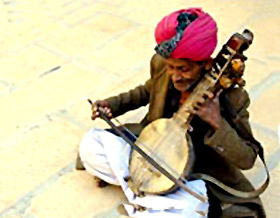There are so many types of violins around the world that an orchestra could be filled with all of them! Here are five more exotic violins.
1. Endingidi, Uganda

This West African one string fiddle is constructed from lizard skin stretched over a wood or horn sound box. The single string is traditionally made from animal sinew, as is the "hair" of the bow.
The instrument is usually accompanied by singing as well as with rattles and drums. It is typically played for rest and relaxation although it is also played at weddings and other ceremonies.
Similar instruments are found throughout West Africa.
To here the instrument being played, click here.
2. Ravanhatta, India

This popular instrument from Western India has two strings: one steel and one of horsehair.
The sound box is made from a coconut shell which has been covered with hide. The bow is made with horsehair and covered with bells.
The ravanhatta has a history of being played by royalty in India. Kings in India have traditionally been patrons of music, and so this instrument was one of the first to be learned by princes.
To hear this instrument being played, click here.
3. Rebab, Java

The Javanese rebab is a two stringed instrument that is traditionally played with the gamelan orchestra. The performer sits on the floor and the spike of the instrument rests on the floor in front of him.
The resonating chamber of the instrument made from a coconut and is covered with goat skin or bladder. The instrument is not very loud but has a very distinctive sound.
To hear a performance on the rebab, click here.
4. Gadulka, Bulgaria

This instrument is an important part of Bulgarian folk music, especially for dancing.
The instrument has three to four main strings which run over the bridge as well as ten sympathetic strings below. The strings are made from steel and are tuned A-E-A.
The instrument does not have a nut and the strings never touch the neck.
The instrument is carved from wood and the face of the gadulka does have a slight arch.
To here it being played, click here.
5. Lijerica, Croatia
 The lijerica is a descendant of the lyra from the Byzantine empire. It has three strings, a carved wooden body, and a horsehair bow.
The lijerica is a descendant of the lyra from the Byzantine empire. It has three strings, a carved wooden body, and a horsehair bow.
The instrument is used to accompany the Croatian lindo dance. It is a traditional instrument in the folk culture of the area but it is also used today in some popular music.
To see the instrument being played in the context of the traditional lindo dance, click here.


